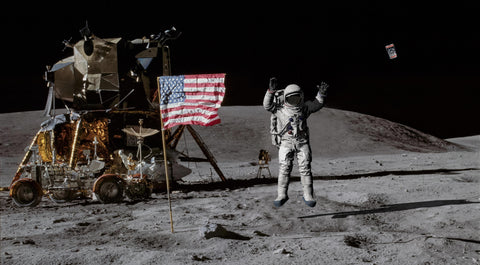
One of the most fascinating aspects of space travel is the challenge of keeping astronauts healthy, nourished, and energized during extended missions. Unlike Earth-bound explorers, astronauts must rely on specially designed food to sustain them as they venture far beyond the planet. Astronaut food has evolved from simple, freeze-dried meals to complex, nutritionally balanced offerings that are critical for both physical and mental well-being in space. In this article, we will explore the history, science, and innovation behind astronaut food, and how it supports human exploration of space.
The Origins of Astronaut Food
In the early years of space exploration, food for astronauts was a basic, often unsophisticated affair. When the first American astronaut, Alan Shepard, went into space in 1961, he was fed simple items like applesauce and puréed meats in vacuum-sealed pouches. The primary goal was to provide nutrition and energy in a form that could be easily consumed in the weightlessness of space. However, the food needed to be compact, lightweight, and non-perishable—challenges that early space agencies struggled to meet.
During the Apollo missions, NASA made significant strides in developing food that would meet the needs of astronauts on long-duration spaceflights. The original Apollo meals were based on freeze-dried and dehydrated foods that astronauts could rehydrate with water. These early meals were not particularly flavorful, and their packaging was often clunky. Nevertheless, they served their purpose, providing the necessary nutrition for astronauts who spent up to two weeks in space.
The Challenges of Space Food
Living and working in space presents a unique set of challenges when it comes to food. One of the biggest issues is the absence of gravity. In a microgravity environment, liquids do not stay in containers, and food particles can float away. This makes meal preparation and consumption much more difficult than on Earth.
Some of the specific challenges astronauts face when eating in space include:
- Gravity and Floating Particles: In the weightlessness of space, food crumbs, droplets of liquids, and even powders can float away and pose a hazard to both equipment and astronauts. For example, floating crumbs could get into sensitive machinery, while liquids could form spheres and interfere with astronauts’ breathing.
- Preservation and Storage: With no refrigeration available on spacecraft, food must be preserved in a way that prevents spoilage. This requires advanced techniques like freeze-drying, dehydration, and vacuum sealing, which remove moisture from food and allow it to be stored for months or even years without spoiling.
- Nutrition: Space travel places unique stressors on the human body. Without gravity, astronauts’ muscles weaken, bones lose density, and the cardiovascular system is affected. Astronaut food must therefore be carefully balanced to ensure astronauts receive the proper amount of vitamins, minerals, proteins, and calories to maintain their health during long-duration missions.
- Psychological Factors: Beyond physical nutrition, food in space also plays a role in the psychological well-being of astronauts. A monotonous or unappetizing diet can lead to food fatigue, which can affect an astronaut’s mood and performance. Space agencies therefore strive to make meals not only nutritionally adequate but also satisfying and comforting.
The Evolution of Space Food
Over the decades, space food has become far more sophisticated, moving beyond basic freeze-dried meals to a variety of nutritious, flavorful, and convenient options. Today, NASA and other space agencies, like the European Space Agency (ESA) and Roscosmos, work with food scientists and chefs to create meals that meet the strict requirements of space travel while also catering to astronauts’ tastes.
Freeze-Drying and Dehydration
Freeze-drying and dehydration are two of the primary methods used to preserve space food. Freeze-drying involves freezing food and then removing the water content through a process called sublimation, where the ice turns directly into vapor. This method preserves the flavor and nutritional content of food while reducing its weight. Dehydration, on the other hand, involves removing moisture through heat, which also results in lighter, shelf-stable foods.
Astronauts can rehydrate freeze-dried meals by adding hot or cold water to them through a special port in the meal package. This makes it possible to prepare a variety of meals, from soups to pasta dishes, with a simple addition of water.
Thermostabilized Foods
Thermostabilization is another method of food preservation used for space meals. This process involves heating food to high temperatures to destroy harmful bacteria and enzymes, then sealing it in airtight containers. These foods are often ready to eat right out of the package, making them convenient for astronauts who may not have the time or means to rehydrate or cook food.
Thermostabilized meals include options like curries, stews, and chili, and they are often favored for their convenience and relatively long shelf life.
Specialized Space Snacks
Astronauts are also given snacks, and some are designed specifically for the space environment. Space-friendly snacks are typically packed in resealable pouches to prevent crumbs or Astronaut Food particles from floating away. These snacks can include trail mix, nuts, granola bars, cookies, and even freeze-dried ice cream, which became a beloved item after being featured in the Apollo program.
One of the most iconic space snacks, freeze-dried ice cream, became a novelty on the ground but served as a fun and morale-boosting treat for astronauts. While it doesn’t melt in the zero-gravity environment, it still provides a sweet taste of Earth.
Fresh Foods in Space
For long-duration missions, fresh food can be a challenge. The International Space Station (ISS) has systems in place for growing some fresh food, such as lettuce, radishes, and even strawberries, using hydroponic or aeroponic methods. The ability to grow fresh produce in space not only provides a nutritious supplement to astronauts’ diets but also boosts their psychological well-being by offering a connection to Earth.
NASA has also experimented with space farming technologies to support future missions to the Moon, Mars, and beyond. This includes researching ways to grow crops in space using minimal resources, as part of efforts to create sustainable food systems for extended missions on other planets.
The Future of Space Food
Looking ahead, space food continues to evolve in response to the challenges posed by long-term space exploration. As missions to Mars and beyond become more feasible, the need for food that is not only nutritious and convenient but also sustainable will become even more critical.
In the near future, astronauts may be able to grow even more diverse foods in space, thanks to advances in plant biology and farming technologies. Space agencies are investigating ways to use the resources available on other planets, such as Martian soil, to grow food, a concept known as “in-situ resource utilization” (ISRU). This could allow astronauts to grow their own crops during deep space missions, reducing the need to carry all food supplies from Earth.
Additionally, the concept of 3D printing Astronaut Food has gained traction in recent years. By using ingredients that are stored as powders, 3D printers could create meals in space by adding water and then printing the Astronaut Food layer by layer. This could offer astronauts greater flexibility and variety in their diets, as well as reduce food waste.
Conclusion
Astronaut food has come a long way since the early days of space exploration, evolving from basic, utilitarian meals to a sophisticated system of nutrition that supports the health and well-being of astronauts on long-duration missions. While space food may never quite match the variety and freshness of what we enjoy on Earth, it plays a critical role in enabling human space exploration. With ongoing innovations in food science, astronauts of the future will likely have access to more diverse, sustainable, and flavorful meals as they venture farther into the cosmos. Whether it’s a hearty stew or a freeze-dried dessert, the Astronaut Food they eat will continue to be a vital part of humanity’s journey beyond Earth.




